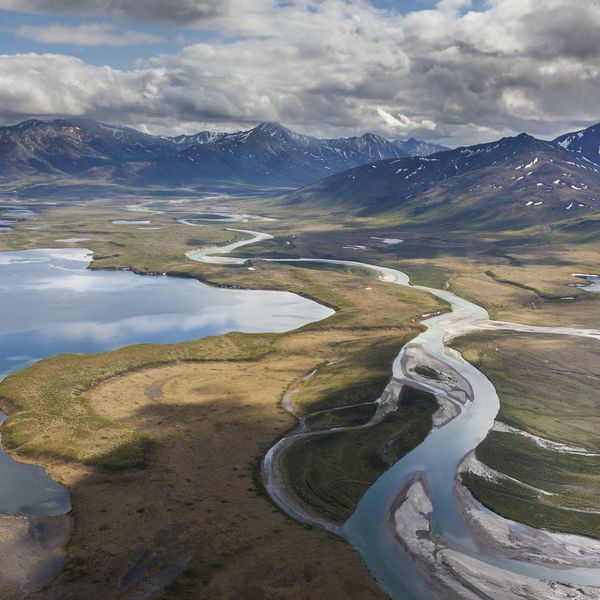Minnesota's Moose in 'Precipitous' Decline
Biologists attribute most of decline of 'iconic species of the north' to increasing temperatures
The moose population in Minnesota is in "precipitous" decline, the state's Department of Natural Resources announced on Wednesday, and adds evidence to a recent report documenting the catastrophe climate change has already brought to the nation's wildlife.
An aerial survey conducted in January estimated Minnesota's moose population at 2,760 animals, which marks a 35% decline from last year and a 52% decline since 2010. The plummeting number prompted the DNR to put a halt on this year's and future years' moose hunting seasons until the population could recover.
"The state's moose population has been in decline for years but never at the precipitous rate documented this winter," said Tom Landwehr, DNR commissioner, adding that the hunting that has occurred in the state is not responsible for the population decline. "This is further and definitive evidence the population is not healthy. It reaffirms the conservation community's need to better understand why this iconic species of the north is disappearing from our state."
At the end of January, the National Wildlife Federation (NWF) released the report Wildlife in a Warming World: Confronting the Climate Crisis, which documented how climate change has already pushed the nation's wildlife into crisis, and warned that warming is particularly problematic for moose in northern Minnesota. From the report:
Biologists attribute most of this decline to increasing temperatures: when it gets too warm moose typically seek shelter rather than foraging for nutritious foods needed to keep them healthy. They become more vulnerable to tick infestations, which have proliferated as the region has warmed. Ticks leave moose weakened from blood loss and with hairless patches where they tried to rub off the ticks. Without protective hair, these animals can die from cold exposure in the winter. Individual moose infested with 50,000 to 70,000 ticks--ten to twenty times more than normal--have been documented.
But as Noah Greenwald, endangered species director at the Center for Biological Diversity, notes, these moose are on a long list of animals threatened by climate change.
"Moose in Minnesota are one of the many wildlife species we're at risk of losing to climate change," said Greenwald. "We need to sharply reduce greenhouse gas pollution now to save Minnesota moose, as well as wolverines, polar bears and many other animals."
An Urgent Message From Our Co-Founder
Dear Common Dreams reader, The U.S. is on a fast track to authoritarianism like nothing I've ever seen. Meanwhile, corporate news outlets are utterly capitulating to Trump, twisting their coverage to avoid drawing his ire while lining up to stuff cash in his pockets. That's why I believe that Common Dreams is doing the best and most consequential reporting that we've ever done. Our small but mighty team is a progressive reporting powerhouse, covering the news every day that the corporate media never will. Our mission has always been simple: To inform. To inspire. And to ignite change for the common good. Now here's the key piece that I want all our readers to understand: None of this would be possible without your financial support. That's not just some fundraising cliche. It's the absolute and literal truth. We don't accept corporate advertising and never will. We don't have a paywall because we don't think people should be blocked from critical news based on their ability to pay. Everything we do is funded by the donations of readers like you. Will you donate now to help power the nonprofit, independent reporting of Common Dreams? Thank you for being a vital member of our community. Together, we can keep independent journalism alive when it’s needed most. - Craig Brown, Co-founder |
The moose population in Minnesota is in "precipitous" decline, the state's Department of Natural Resources announced on Wednesday, and adds evidence to a recent report documenting the catastrophe climate change has already brought to the nation's wildlife.
An aerial survey conducted in January estimated Minnesota's moose population at 2,760 animals, which marks a 35% decline from last year and a 52% decline since 2010. The plummeting number prompted the DNR to put a halt on this year's and future years' moose hunting seasons until the population could recover.
"The state's moose population has been in decline for years but never at the precipitous rate documented this winter," said Tom Landwehr, DNR commissioner, adding that the hunting that has occurred in the state is not responsible for the population decline. "This is further and definitive evidence the population is not healthy. It reaffirms the conservation community's need to better understand why this iconic species of the north is disappearing from our state."
At the end of January, the National Wildlife Federation (NWF) released the report Wildlife in a Warming World: Confronting the Climate Crisis, which documented how climate change has already pushed the nation's wildlife into crisis, and warned that warming is particularly problematic for moose in northern Minnesota. From the report:
Biologists attribute most of this decline to increasing temperatures: when it gets too warm moose typically seek shelter rather than foraging for nutritious foods needed to keep them healthy. They become more vulnerable to tick infestations, which have proliferated as the region has warmed. Ticks leave moose weakened from blood loss and with hairless patches where they tried to rub off the ticks. Without protective hair, these animals can die from cold exposure in the winter. Individual moose infested with 50,000 to 70,000 ticks--ten to twenty times more than normal--have been documented.
But as Noah Greenwald, endangered species director at the Center for Biological Diversity, notes, these moose are on a long list of animals threatened by climate change.
"Moose in Minnesota are one of the many wildlife species we're at risk of losing to climate change," said Greenwald. "We need to sharply reduce greenhouse gas pollution now to save Minnesota moose, as well as wolverines, polar bears and many other animals."
The moose population in Minnesota is in "precipitous" decline, the state's Department of Natural Resources announced on Wednesday, and adds evidence to a recent report documenting the catastrophe climate change has already brought to the nation's wildlife.
An aerial survey conducted in January estimated Minnesota's moose population at 2,760 animals, which marks a 35% decline from last year and a 52% decline since 2010. The plummeting number prompted the DNR to put a halt on this year's and future years' moose hunting seasons until the population could recover.
"The state's moose population has been in decline for years but never at the precipitous rate documented this winter," said Tom Landwehr, DNR commissioner, adding that the hunting that has occurred in the state is not responsible for the population decline. "This is further and definitive evidence the population is not healthy. It reaffirms the conservation community's need to better understand why this iconic species of the north is disappearing from our state."
At the end of January, the National Wildlife Federation (NWF) released the report Wildlife in a Warming World: Confronting the Climate Crisis, which documented how climate change has already pushed the nation's wildlife into crisis, and warned that warming is particularly problematic for moose in northern Minnesota. From the report:
Biologists attribute most of this decline to increasing temperatures: when it gets too warm moose typically seek shelter rather than foraging for nutritious foods needed to keep them healthy. They become more vulnerable to tick infestations, which have proliferated as the region has warmed. Ticks leave moose weakened from blood loss and with hairless patches where they tried to rub off the ticks. Without protective hair, these animals can die from cold exposure in the winter. Individual moose infested with 50,000 to 70,000 ticks--ten to twenty times more than normal--have been documented.
But as Noah Greenwald, endangered species director at the Center for Biological Diversity, notes, these moose are on a long list of animals threatened by climate change.
"Moose in Minnesota are one of the many wildlife species we're at risk of losing to climate change," said Greenwald. "We need to sharply reduce greenhouse gas pollution now to save Minnesota moose, as well as wolverines, polar bears and many other animals."

